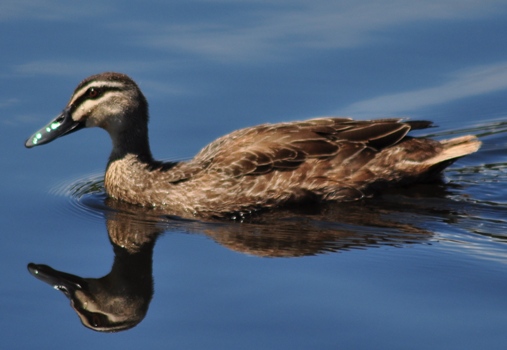Feeding Birds
To feed or not to feed: is feeding waterbirds a good idea?
Feeding ducks processed food, like bread might seem kind, however it
- is bad for their health - they can become obese
- pollutes the water, and
- encourages them to become dependent on humans.
One of the most common ducks that frequents the constructed wetlands are Black Ducks or Anas superciliosa. Black Ducks can be identified by a dark facial stripe that runs through their eye. It looks like eye liner. Their diet is mainly vegetable matter, particularly sedges, smart weeds and grasses, with a large proportion of seeds. Around one third of Black Duck diet can be made up of freshwater insects.
A Black Duck captured at the Dickson wetland.
Image: Mark Jekabsons
Other birds commonly seen at the wetlands are: Wood Ducks, Grebes (Australasian and Hoary-Headed), Hardhead or White-Eyed Duck and Little Pied Cormorant. Wood Ducks are a grazing duck and enjoy grazing on grasses, clovers, smart weeds as well as wetland plants.

Wood ducks love grazing on newly germinated grass and wetland plants. It's a good idea to protect new plants with netting or guards.
Image: Mark Jekabsons

Plovers. Image: Mark Jekabsons
Often seen on perches in the wetland, is the diving bird, the Little Pied Cormorant. It feeds on crustaceans like Yabbies and Freshwater Shrimps and fish. The Hardhead is also a bird that enjoys protein. It prefers deeper water and dabbles for animal material, particularly molluscs. The Grebes share a smilar diet and eat water beetles, small fish and larvae.
The ACT Government is working with volunteers from the Dickson Wetland Carers to produce a brochure of the twelve most common birds encountered at the wetlands. It will include waterbirds as well as birds that use the edge of the wetland or fly over the water feeding on insects. The online brochure will be available in early 2014.
Reference
Lintermans, Mark and Osborne, William (2002) 'Wet and Wild: a field guide to freshwater animals of the Southern Tablelands and High Country of the ACT and NSW'. Environment ACT: Canberra.


